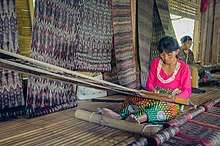T'nalak
T'nalak (also spelled tinalak), is a weaving tradition of the T'boli people of South Cotabato, Philippines. T'nalak cloth are woven from abacá fibers. The traditional female weavers are known as dream weavers, because the pattern of the t'nalak cloth are inspired by their dreams.
_(40246611432).jpg)
Introduction
T'nalak is a traditional cloth found in Mindanao island made by a group of people in Lake Sebu, South Cotabato called T'bolis, Tboli people. This traditional cloth is hand-woven made of Abaca fibers which traditionally has three primary colors, red, black and the original color of the Abaca leaves. The colorant of the materials are naturally dyed boiled in with bark, roots and leaves of plants. It is a heritage and believed that the intricate and creative patterns of the Tinalak was seen on their dreams and made it on to work. They can't create a design of the Tinalak if they haven't dreamed of it. They are sometimes called the "Dream Weavers".

The T’nalak fabric holds a special and prominent place in [T’boli] culture. It is ever present in significant turning points in a [Tboli] life, such as birth, marriage, and death. It is the medium which sanctifies these rites, enveloping them in the length of its fabric like a benediction. It has also often been referred to as “woven dreams”. It is exactly that, and more. In a culture which didn’t have a form of writing, the T’nalak served as both Literature and Art. The [T’bolis] expressed everything they are in the T’nalak: their dreams, beliefs, myths and even their religion. Making use of the various geometrical patterns and the trademark red, black and white colors, the [T’bolis] weave the natural and the supernatural in the abaca strands of the T’nalak. Furthermore, the weaving process integrates the personal, the social and the cultural. After a weaver reaches a certain degree of expertise, she becomes a “master weaver” – someone who can interpret and take inspiration from dreams, hence the term “dreamweavers”. By all accounts, this seems to be an intense personal experience for the weaver, and the moment she succeeds in doing this is the moment she becomes an artist. And then it is also social because the T’nalak binds together all that the [T’boli]people believe in. The skill of the weaver gathers in the T’nalak all the elements that make the [T’boli] social life. Finally, it is cultural in that it is the means through which other tribes identify the [T’bolis] since the T’nalak is uniquely and distinctly [T’boli].
Tinalak are also their prized possession at marriage, even the covering for childbirth for ensuring safe delivery and for trading. Whenever they sell their work, they put a brass ring around it as for the spirits to allow them or to please. It is believed that cutting the cloth would deliver sickness.
See also
| Wikimedia Commons has media related to T'nalak. |